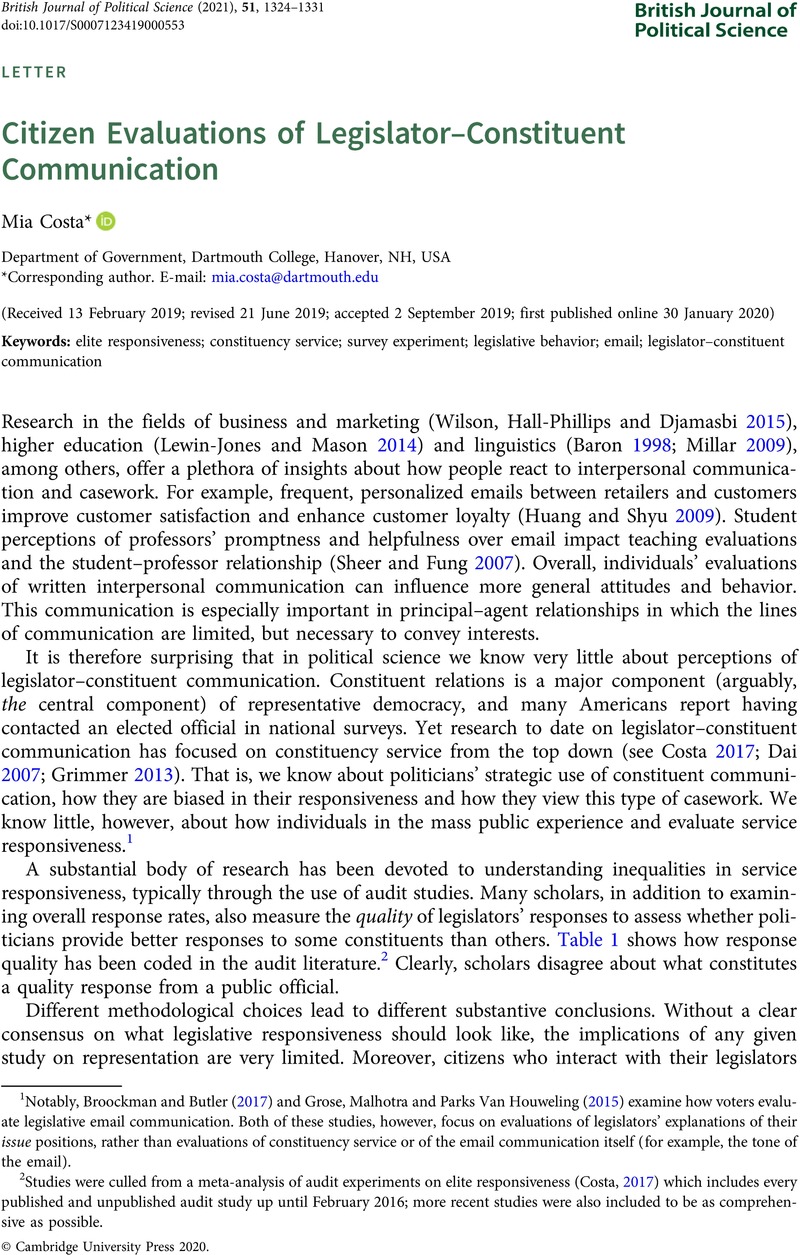Crossref Citations
This article has been cited by the following publications. This list is generated based on data provided by Crossref.
Costa, Mia
2021.
Citizen Evaluations of Legislator–Constituent Communication.
British Journal of Political Science,
Vol. 51,
Issue. 3,
p.
1324.
Costa, Mia
2021.
Ideology, Not Affect: What Americans Want from Political Representation.
American Journal of Political Science,
Vol. 65,
Issue. 2,
p.
342.
Liu, Evita Huaiching
Chambers, Cassandra R.
and
Moore, Celia
2023.
Fifty years of research on leader communication: What we know and where we are going.
The Leadership Quarterly,
Vol. 34,
Issue. 6,
p.
101734.
Henderson, Geoffrey
Hertel-Fernandez, Alexander
Mildenberger, Matto
and
Stokes, Leah C.
2023.
Conducting the Heavenly Chorus: Constituent Contact and Provoked Petitioning in Congress.
Perspectives on Politics,
Vol. 21,
Issue. 1,
p.
191.
Bauer, Nichole M.
and
Cargile, Ivy A. M.
2023.
Women Get the Job Done: Differences in Constituent Communication from Female and Male Lawmakers.
Politics & Gender,
Vol. 19,
Issue. 4,
p.
1110.
Muraoka, Taishi
2024.
Incentives to cultivate a diaspora vote and rhetorical involvement in foreign elections: Lessons from Colombian politicians’ involvement in the 2020 US presidential election.
Journal of Information Technology & Politics,
Vol. 21,
Issue. 4,
p.
465.
Robison, Joshua
2024.
Explanation Giving Promotes Democratic Satisfaction Regardless of Respondent Partisanship.
Political Behavior,
Vol. 46,
Issue. 4,
p.
2699.
Bauer, Nichole M.
Barnes, Kenlea
Dukes, Elizabeth
and
Williams, Lailah
2024.
Gendered Differences in Fundraising Appeals Among Congressional Candidates.
Journal of Political Marketing,
p.
1.
BARCELÓ, JOAN
and
VELA BARÓN, MAURICIO
2024.
Political Responsiveness to Conflict Victims: Evidence from a Countrywide Audit Experiment in Colombia.
American Political Science Review,
Vol. 118,
Issue. 1,
p.
21.
Busby, Ethan C.
Thompson, Andrew Ifedapo
and
Yi, Suzy
2025.
Do They Even Care? Empirical Evidence for the Importance of Listening in Democracy.
Political Communication,
Vol. 42,
Issue. 4,
p.
556.
Busby, Ethan C.
Thompson, Andrew Ifedapo
Vierbuchen, Tomo
and
Yi, Suzy
2025.
Unheard Voices: The Importance of Intersectionality in Responsiveness and the Systematic Ignoring of Black Men by Elected Officials.
Political Behavior,
MONGRAIN, PHILIPPE
JUNIUS, NINO
and
BRACK, NATHALIE
2025.
As you wish? Public preferences for models of representation and MPs’ role orientations.
European Journal of Political Research,
Vol. 64,
Issue. 3,
p.
1208.
Ethan Yoo, Seung Wook
2025.
Explicit partisan candidate support and bureaucratic responsiveness in hyper-partisan environment: Evidence from a field experiment.
Electoral Studies,
Vol. 93,
Issue. ,
p.
102890.



